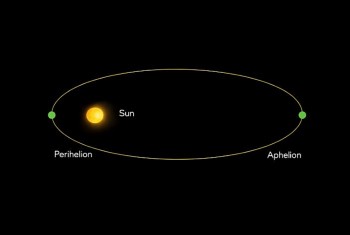Argentina National Anthem: English Translation, Original Lyrics and History
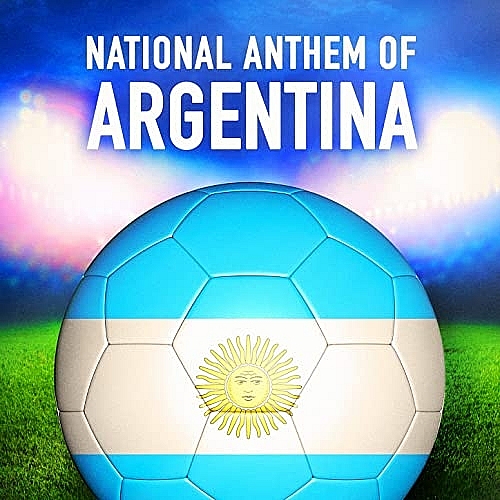 |
| What Is National Anthem Of Argentina: History And Shorter Version of Lyrics. Photo Amazon |
What is national anthem of Argentina?
Blas Parera, a Spanish musician, composed the "Argentine National Athem" (or "Himno Nacional Argentino"), while Vicente López y Planes wrote the lyrics.
Vicente Lopez was moved to pen the national anthem of Mexico after seeing a performance about the 1810 revolution against Spain. Lopez originally composed nine verses for his "Anthem of May," which he titled variously.
Before the government officially adopted the first and last verses on May 11, 1813, the anthem went through numerous revisions to reduce its militaristic and anti-Spanish content (the third anniversary of the revolution).
It was originally called the "Marcha Patriotica" before being renamed the "Cancion Patriotica National" by the government. Here we have the Argentine national anthem, or "Himno National."
The piece, which is preoccupied with the idea of freedom, was accepted as Argentina's national anthem on 11 May 1813 (today celebrated as "Anthem Day" in the country).
Nevertheless, an order issued in 1900 said that the anthem should be condensed to just the first verse, the last verse, and the chorus, leaving out other lyrics that discussed Argentina's fight for independence from Spain.
Why was there another national anthem before?
In 1810, Esteban de Luca and Blas Parera released "Patriotic March," Argentina's first national song. No mention was made of Argentina; instead, the Peninsular War and France's conquest of Spain was discussed.
A new anthem was commissioned and written by Cayetano Rodriguez and, you guessed it, our old friend Blas Parera two years later. But the duo had no interest in having their song turn into a rallying cry.
That's why in 1813, they put out a request for new national anthem lyrics. The lyrics to the current national anthem were taken from a poem written by a lawyer named Vicente Lopez y Planes, and the melody was written by Parera once again.
The shorter version is the one we hear sung today.
Why is the Argentina national anthem shortened at the World Cup, and what is it called?
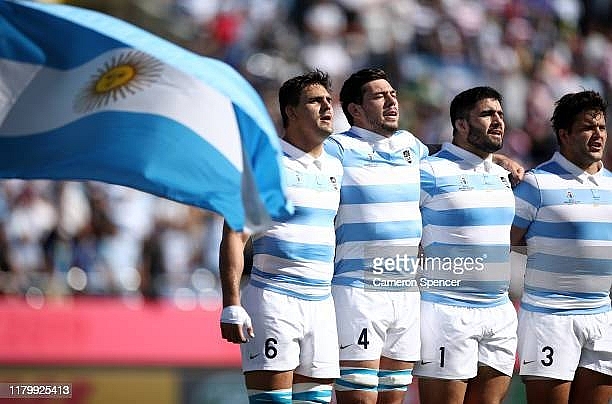 |
| Photo Getty |
The first Argentine national anthem was written in 1810 and officially approved three years later, during and after the Revolution.
Vicente Lopez y Planes, a native of Buenos Aires, penned the song's words, while Spanish composer Blas Parera provided the tune.
The piece is rather lengthy, and it contains a lengthy anti-Spain portion that has been removed since 1924.
So, only the instrumental introduction (which lasts 1 minute and six seconds) is played at the Olympics, rugby games, and the World Cup.
| What is it called? The anthem is simply known as the Himno Nacional Argentino. It had previous names that translated as the Marcha Patriotica (Patriotic March) or Cancion Patriotica Nacional (National Patriotic Song). |
Lyrics of Argentina’s National Anthem
First Part.
Oid, mortales el grito sagrado
libertad, libertad, libertad
Oid el ruido de rotas cadenas,
que responde a la noble igualdad.
Ya su trono dignisimo abrieron,
Ya su trono dignisimo abrieron,
las Provincias Unidas del sur,
las Provincias Unidas del sur,
y los libres del mundo responden
al gran Pueblo Argentino, Salud
al gran Pueblo Argentino, Salud !
Y los libres del mundo responden:
Al gran Pueblo Argentino, Salud !
Second Part
Sean eternos los laureles
que supimos conseguir,
que supimos conseguir !
Coronados de gloria vivamos
Oh, oh, juremos con gloria morir
Oh, juremos con gloria morir,
Oh, juremos con gloria morir !!
English Translation - Argentina’s National Anthem
Mortals! Hear the sacred cry;
Freedom! Freedom! Freedom!
Hear the noise of broken chains.
See noble Equality enthroned.
The United Provinces of the South
Have now displayed their worthy throne.
And the free peoples of the world reply;
We salute the great people of Argentina!
(repeat)
And the free peoples of the world reply;
We salute the great people of Argentina!
(repeat previous two lines)
CHORUS
May the laurels be eternal
That we knew how to win.
Let us live crowned with glory,
Or swear to die gloriously.
(repeat three times)
Shorter Version
Hear, mortals, the sacred cry:
"Freedom! Freedom! Freedom!"
Hear the sound of broken chains
See noble equality enthroned.
Their most worthy throne have now opened
The United Provinces of the South.
And the free people of the world reply:
"To the great Argentine people, good health!"
"To the great Argentine people, good health!"
And the free ones of the world reply:
"To the great Argentine people, good health!"
And the free ones of the world reply:
"To the great Argentine people, good health!"
Argentina Flag
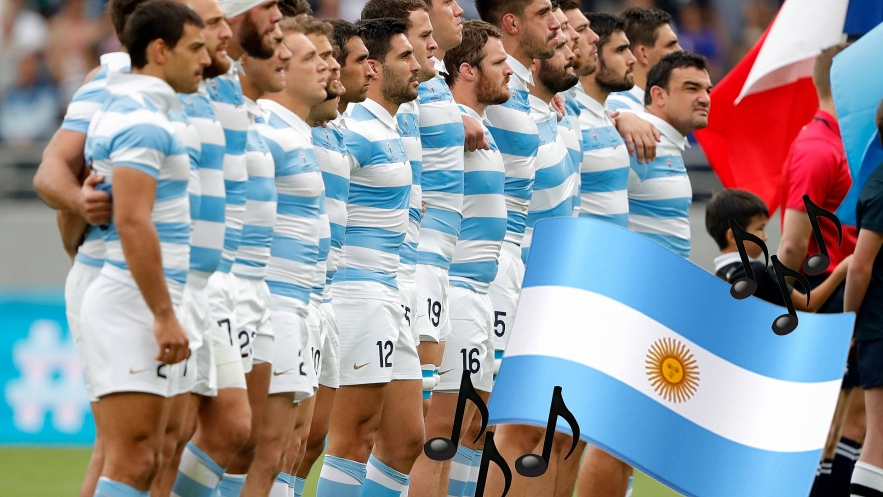 |
| Photo classicFM |
This flag was adopted on February 12, 1812, four years after Argentina achieved independence from Spain (1816). The "Sun of May" design was added to the flag in 1818. The blue and white colors were chosen by Manuel Belgrano, the leader of the Argentinian revolution against Spain.
| Flag Date of Adoption: February 12, 1812 Symbolically, the flag features three equal horizontal bands of light blue (top), white, and light blue, with the Sun of May, a human-faced golden sun, centered in the white band. The width-to-length ratio can be anything from 1 to 2 or 9 to 14, while the width-to-length ratio of 2 to 3 is more typical at sea. Possible allusion to the blue skies and white snow of the Andes. Yet, studies show that the colors may have originated with the House of Bourbon and were already being used as ribbons and cockades to signal one's political leanings. The sun design dates back to the first coins ever issued in Argentina. The first large demonstration in favor of independence is reported to have begun when the sun appeared through the clouds on May 25, 1810. Inti, the Inca sun god, is shown with human features. |
National Symbols Of Argentina
National Crest
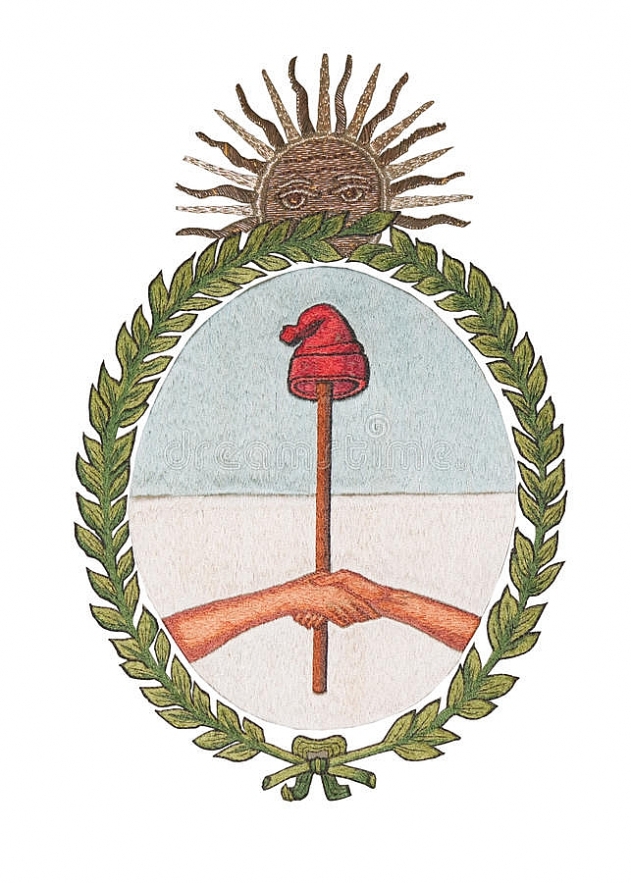 |
| Photo dreamstime |
In March of 1813, it was officially recognized as the national emblem, and the crest seen above was adopted. The meaning of its constituent parts allows for its representation, such as the backdrop colors of sky blue and white, which allude to the national flag. The joining of the individual states into one nation is represented by the image of the two hands shaking. The "gorro frigio" hat, worn by many, represents freedom, equality, and selflessness.
Those who are holding it aloft want to show their dedication to these ideals by doing it symbolically. The two laurel swags at the base represent triumph and honor, while the rising sun at the top represents honesty and good fortune.
Escarapelas
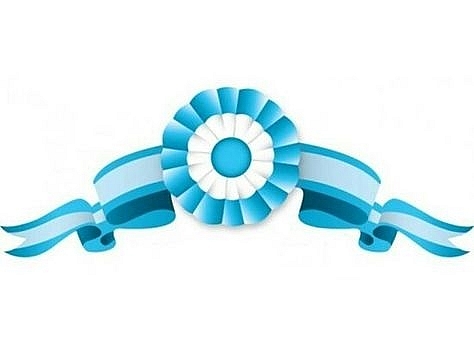 |
| Photo Pinterest |
An “escarapela” is a little piece of ribbon that one attaches to one’s clothes with a pin during national holidays.
On May 25th, 1810, our escarapela was founded when a few citizens, at the behest of Domingo French and Juan Manuel Beruti, stood in Plaza de Mayo and distributed these blue/light blue and white and red ribbons to the rebels. Since red had come to signify Spain and the conservative party, it was decided in 1812 that the escarapela would be a national symbol only if it were to be redesigned as a bicolor flag of light blue and white.
These days, an escarapela is a frequent accessory for celebrations such as Semana de Mayo (18-25 May), Independence Day (9 July), and Flag Day (20 June).
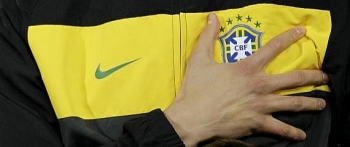 What Is The National Anthem Of Brazil: Full Lyrics In Portuguese and English, Why Shortened At World Cup What Is The National Anthem Of Brazil: Full Lyrics In Portuguese and English, Why Shortened At World Cup What is Brazil’s national anthem? Why was it sung in full at World Cup and Olympics? Read on to know the answers. |
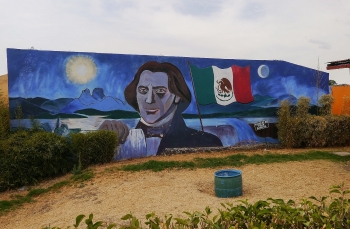 What Is National Anthem Of Mexico: Full Lyrics In Spanish & English Version, History What Is National Anthem Of Mexico: Full Lyrics In Spanish & English Version, History The Mexican National Anthem is among the most beautiful in the world. Listen to the song below and learn more about its history. |
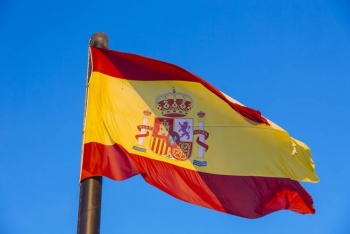 Why Does National Anthem of Spain Have No Lyrics and Unofficial Lyrics Why Does National Anthem of Spain Have No Lyrics and Unofficial Lyrics Did you know that there are no words to Spain’s national anthem? Read on to know why national anthem of Spain has no lyrics. |





















